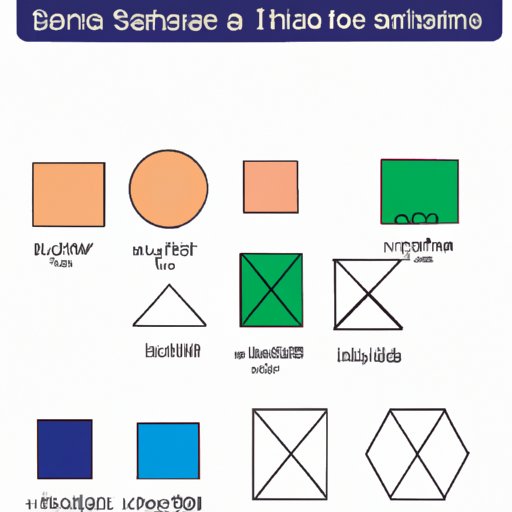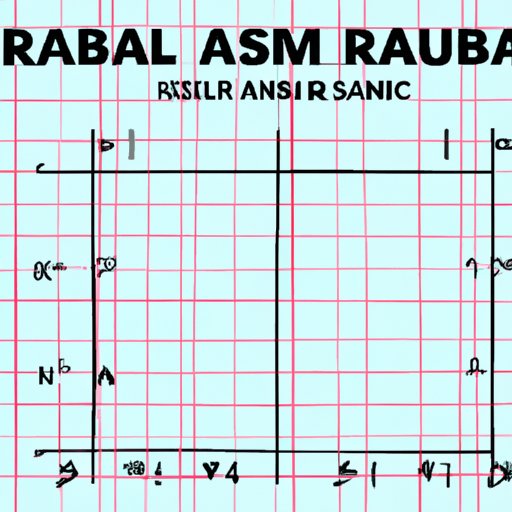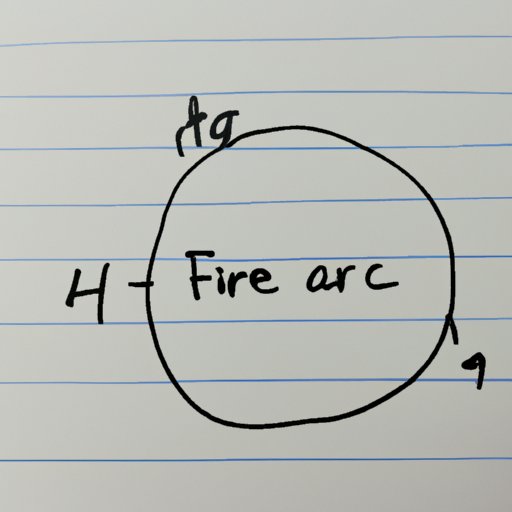Introduction
Area math is a branch of mathematics that deals with calculating the area of two-dimensional shapes. It involves using formulas to measure the area of different shapes, including squares, rectangles, triangles, circles, and other composite figures. This article will provide an in-depth look at how to find the area of different shapes and explain how to solve problems involving area calculations.
Explain the Basics of Area Calculations
Before diving into the specifics of finding the area of different shapes, it’s important to have a basic understanding of what area is and how it is calculated. Area is a measure of the size of a two-dimensional shape or surface. The area of a shape can be determined by using a formula specific to the type of shape being measured.
Identifying Types of Shapes
The first step in calculating the area of a shape is to identify the type of shape. The most common types of shapes are squares, rectangles, triangles, circles, and composite figures (shapes composed of multiple smaller shapes). It’s important to be able to recognize each type of shape so that the correct formula for calculating its area can be used.

Understanding the Formula for Area
Once the type of shape has been identified, the next step is to use the appropriate formula to calculate its area. Each type of shape has its own unique formula that must be used to accurately calculate its area. For example, the area of a square is equal to the length of one side times itself, while the area of a circle is equal to pi times the radius squared.

Examples of Basic Shape Calculations
Once the appropriate formula has been identified, it’s time to apply it. Here are some examples of area calculations for basic shapes:
- The area of a square with a side length of 4 is 16 (4 x 4 = 16).
- The area of a rectangle with a length of 5 and a width of 3 is 15 (5 x 3 = 15).
- The area of a triangle with a base of 6 and a height of 4 is 12 (6 x 4 ÷ 2 = 12).
- The area of a circle with a radius of 5 is 78.5 (π x 5² = 78.5).

Demonstrate How to Use the Formula for Finding the Area of a Square or Rectangle
For squares and rectangles, the formula for calculating the area is simple: multiply the length of one side by itself (for a square) or by the other side (for a rectangle). Here is an example of how to use this formula:
If we have a square with a side length of 4, then we can calculate the area as follows: 4 x 4 = 16, so the area of the square is 16.
If we have a rectangle with a length of 5 and a width of 3, then we can calculate the area as follows: 5 x 3 = 15, so the area of the rectangle is 15.
Show How to Calculate the Area of a Triangle
The formula for calculating the area of a triangle is a bit more complicated than for squares and rectangles. To calculate the area of a triangle, we need to multiply the base of the triangle by the height, then divide by 2. Here is an example of how to use this formula:
If we have a triangle with a base of 6 and a height of 4, then we can calculate the area as follows: 6 x 4 ÷ 2 = 12, so the area of the triangle is 12.

Describe How to Find the Area of a Circle
The formula for calculating the area of a circle is quite different from the formulas for squares, rectangles, and triangles. To calculate the area of a circle, we need to multiply pi (3.14) by the radius of the circle squared. Here is an example of how to use this formula:
If we have a circle with a radius of 5, then we can calculate the area as follows: π x 5² = 78.5, so the area of the circle is 78.5.
Introduce the Concept of Composite Figures and How to Calculate Their Areas
Composite figures are shapes composed of two or more basic shapes. To calculate the area of a composite figure, we need to add up the areas of the individual shapes that make up the composite figure. Here is an example of how to do this:
If we have a composite figure made up of a triangle with a base of 6 and a height of 4, and a square with a side length of 4, then we can calculate the area as follows: 6 x 4 ÷ 2 = 12 (area of triangle) + 4 x 4 = 16 (area of square) = 28, so the area of the composite figure is 28.
Illustrate How to Find the Area of Irregular Shapes Using Triangles, Parallelograms, or Trapezoids
For irregular shapes, we can use the same formula as for triangles, parallelograms, or trapezoids to calculate the area. We just need to break the irregular shape down into smaller shapes that can be measured using these formulas. Here is an example of how to do this:
If we have an irregular shape made up of two triangles and a parallelogram, then we can calculate the area as follows: 6 x 4 ÷ 2 = 12 (area of first triangle) + 8 x 6 ÷ 2 = 24 (area of second triangle) + 8 x 4 = 32 (area of parallelogram) = 68, so the area of the irregular shape is 68.
Give Examples of Problems Involving Area Calculations
Now that we have covered the basics of area calculations, let’s take a look at some examples of problems involving area calculations. Here are some common problems that involve area calculations:
- Calculating the area of a room.
- Determining the amount of paint needed to cover a wall.
- Finding the size of a lawn.
To solve these types of problems, we need to use the appropriate formula for calculating the area of the relevant shape. For example, if we want to calculate the area of a room, we need to use the formula for calculating the area of a rectangle. If we want to determine the amount of paint needed to cover a wall, we need to use the formula for calculating the area of a triangle.
Conclusion
In conclusion, area math is an important branch of mathematics that involves using formulas to calculate the area of two-dimensional shapes. This article has provided a comprehensive overview of how to find the area of different shapes, from basic shapes such as squares and triangles to more complex shapes such as composite figures and irregular shapes. With the help of this article, you should now have a better understanding of how to solve problems involving area calculations.
For further help with area math calculations, there are many online resources available, including tutorials, worksheets, and calculators. Additionally, your school may offer classes or tutoring sessions on area math, which can be a great way to get extra help with your area math calculations.
(Note: Is this article not meeting your expectations? Do you have knowledge or insights to share? Unlock new opportunities and expand your reach by joining our authors team. Click Registration to join us and share your expertise with our readers.)
